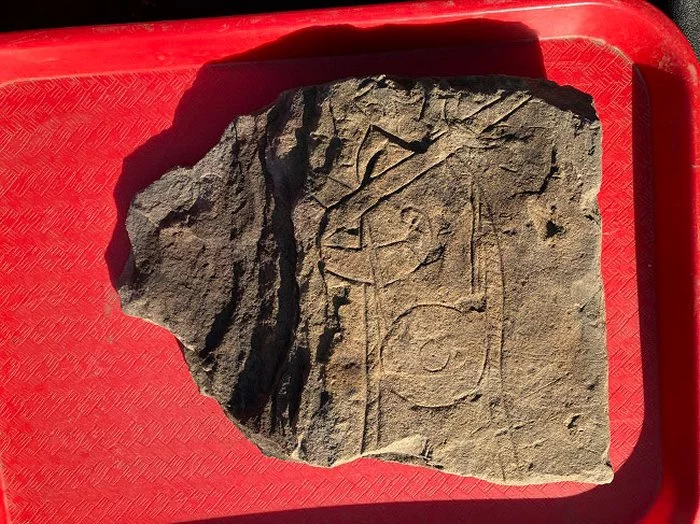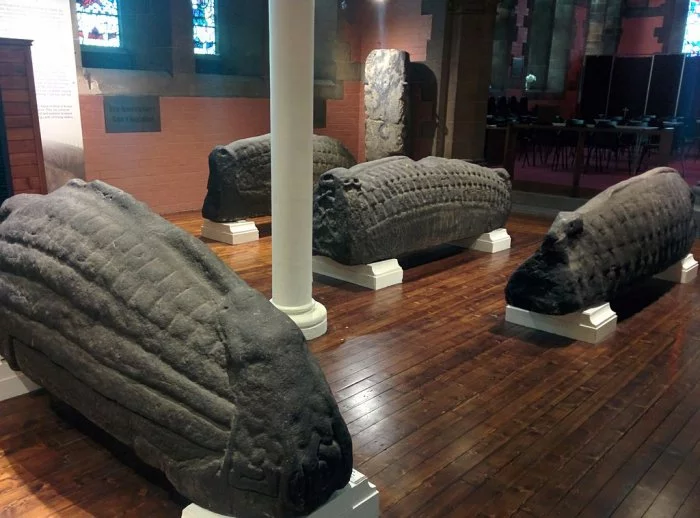Remarkable Early Medieval ‘Govan Warrior’ Stone Discovered In Glasgow, Scotland
An archaeological dig within the churchyard at Govan Old Parish Church in Glasgow has uncovered a “remarkable” early medieval ‘Govan Warrior’ stone.

The dig, led by the University of Glasgow’s Professor Stephen Driscoll and Clyde Archaeology, took place during a community fun day at the church on Saturday.
The early medieval carved stone is “quite unlike” any others discovered at the ancient site – which is celebrated for the richness of its Viking-age sculpture.
The stone portrays a man side-on carrying a round shield and a shaft over their shoulder. The man is probably carrying either a sword or a spear and can be described as a warrior.
While much of the warrior’s face has been damaged since it was carved over a thousand years ago, remarkable details suggest a flowing pony-tail and a sharply pointed beard.
The oldest known Christian site in Glasgow, Govan Old was built in 1888 and stands on a religious site dating back to the sixth century.
In 2007, Reverend Tom Davidson Kelly, a former minister of the church, described it as “possibly the most significant church in Glasgow, including the Cathedral”.
Govan Old is also home of the Govan Stones museum, which contains one of the finest collections of early medieval and Viking-age sculpture in Europe.
He also claimed the building was being used as a centre of worship before the formation of Scotland as a nation.
The collection includes over 30 sculptures produced by the Viking-age Kingdom of Strathclyde, a lost kingdom of Old Welsh-speaking Britons who dominated the Clyde valley from the 5th – 11th centuries AD.
Professor Stephen T. Driscoll next to a ‘hogback’ stone
It includes five hogback monuments dating back to the ninth and 10th centuries, which are thought to have been originally used as grave markers.
The new find, currently nicknamed the ‘Govan Warrior’, is exceptional for its quality even amongst the superb existing collection, which includes the unique Govan Sarcophagus, the Govan Cross and five hogback gravestones, a Scandinavian-style funerary monument that dates to the 9th/10th centuries.
The Govan Warrior is unique within the existing collection due to its stylistic characteristics, which has drawn parallels with Pictish art and carvings from the Isle of Man. Unlike the other stones in the Govan collection, whose chunky style of carving is so distinctive that it has been described as a school of carving in its own right (the ‘Govan School’).
The Govan Warrior is lightly incised, which may bring parallels with famous Pictish stones like the Rhynie Man from Aberdeenshire.
The Excavations at Govan Old were undertaken by the University of Glasgow under the leadership of Professor Stephen Driscoll, also a Trustee of Govan Heritage Trust, the custodians of Govan Old church since 2016.
The Govan Warrior stone was discovered during a community fun day organised as part of Glasgow Doors Open Days Festival, co-ordinated by Glasgow Building Preservation Trust.

Over 500 people visited the site over the weekend and dozens of volunteers from the Govan community participated in excavations for the first time, alongside archaeology students from the University of Glasgow and Clyde Archaeology.
About the discovery, Professor Stephen Driscoll said: “It’s a style that makes us think both about the Pictish world and also about the Isle of Man and it’s interesting that we are halfway between these two places. Govan is the ideal place for these two artistic traditions or styles to come together.
“This is probably the most important find that I’ve made in my thirty years of working at Govan Old. The new stone is very exciting because it takes the collection to a different cultural place as it does not look like the heavier and chunkier ‘Govan School’ style. The new stone is much more delicate in its execution using finer shallow incisions.”




